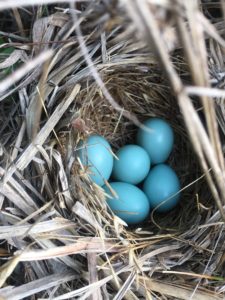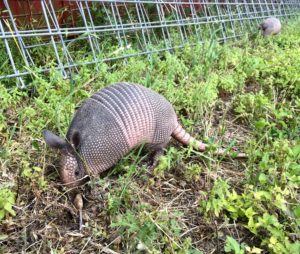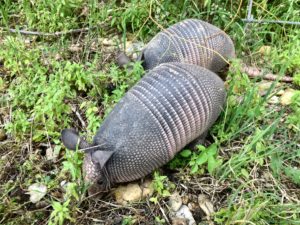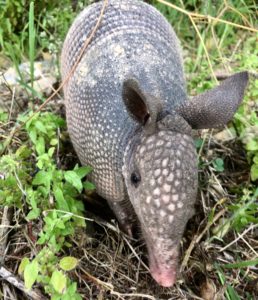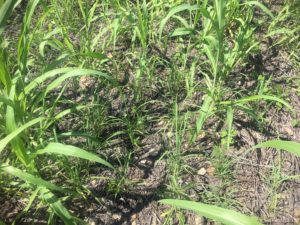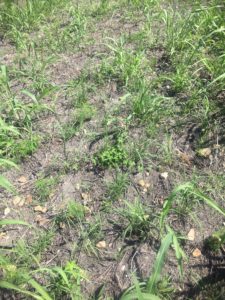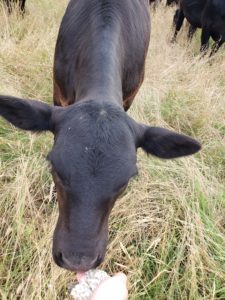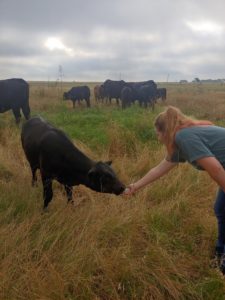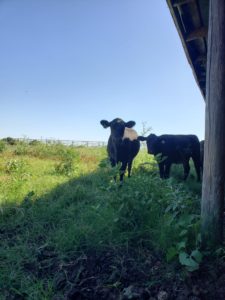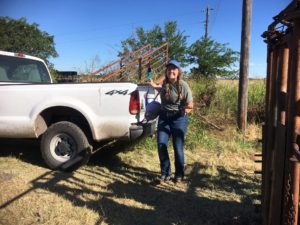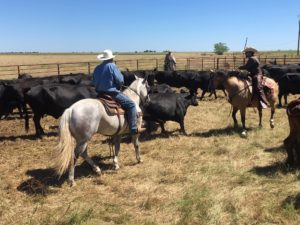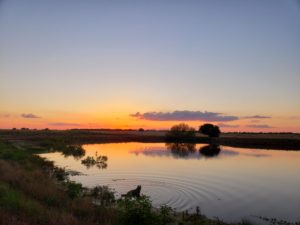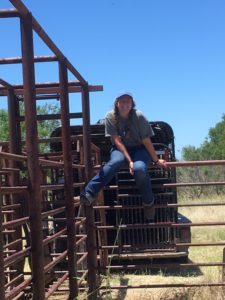Aflatoxion Contamination and Ear Rot Video of 7/17/2020 Dr. Isakeit
2020 Corn Crop Issues & Prevention Methods Video 7/17/2020 Dr. Isakeit
Dani Miller Wildlife Biologist
In recent weeks, I have been spending my mornings cut-stumping mesquite within the farm’s Landowner Incentive Program (LIP) project area, which will eventually be planted with native grasses and forbs. The removal of mesquite will allow for more effective coverage of herbicide applications in advance of the planting, as well as clearing the way for the planting itself. Kyra, our farm intern, assisted me during the first week, during which we identified efficient techniques for this process together.
Many of the individual plants in LIP had already been hit with one or two leaf-spray applications during the summers of 2018 and 2019, and if the treatment was completely successful on an individual plant and killed it, the stems and branches were leafless, pale, and brittle, and would easily crack and fall over when pressure was applied, such as with one’s foot. If the plant was not completely killed, or had not received a leaf-spray treatment, the stems were usually a darker brown and very pliable, often with visible green leaves. Unlike the completely dead plants, the remaining stumps of live individuals received an application of a solution of the appropriate woody herbicide mixed with diesel via a backpack sprayer immediately after the stems or branches were cut off just above the ground. Particular care was taken to ensure the cambium layer, a ring near the outer edge, was covered, as that is where the chemical will be absorbed into the root system to kill the rest of the plant and prevent resprouting. The majority of plants in the pasture we’ve so far covered had stems or branches that were small enough to cut down with large hand-held loppers, but plants with a trunk or branch larger than about two inches in diameter usually required a chainsaw for removal. All cut branches were picked up and placed into centralized piles as we worked across the pasture, so as to prevent them from becoming hazards for tires. Kyra and I cleared about 18 acres together, putting in about 33 hours combined, and I have since cleared another 16 acres with approximately 32 more to clear.
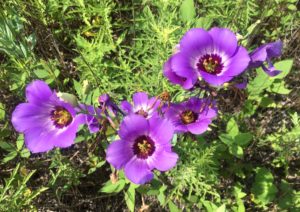
Not long ago, I drove to San Marcos with a small gooseneck trailer to pick up eight rolls of 6.25’x360’ 4 ounce-weight nonwoven geotextile (see photo). This material will be used in construction of the Partners Project walking trail, as an impediment for vegetation growing up through the trail and a sort of net to keep the finer pieces and particles of the crushed limestone aggregate from sinking into the soil underneath the trail and eroding away. Construction of the trail is expected to occur from late July into August, as I am finalizing aggregate delivery and equipment rental now. My first t’bench (photo included) will make its way out there afterwards. I’ve also included two photos of the Partners site as it currently exists, with the orange flags marking the proposed half-mile trail route, as well as a photo of some of our native Texas bluebells (Eustoma grandiflorum). The trail will be built and some structures added this summer, with the prescribed burn planned for this winter (structures will either be moved or the vegetation around them cleared in advance of the burn). The next step will be to observe which vegetation species sprout post-burn and in what densities, in order to determine if one or more applications of herbicide need to occur in advance of planting the native grasses and forbs.


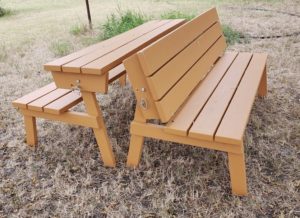
This past week, in addition to cut-stumping, I assisted farm personnel in patching some of our barbed wire fencing at a wash-out, where water runoff over time had caused enough soil erosion to create a sizable gap between the bottom wire of the fence and the ground. We also built a 3-wire electric fence to reinforce one of the farm’s older sections of permanent fence separating the grazing pastures from each other. Participating in the construction of the hot wire fence was a new experience for me, and one I will remember for future fence work, as it is an important skill in the wildlife field as well as in agriculture. While cut-stumping and fence work are not particularly exciting tasks, especially in the summer heat, both are critical to habitat management efforts, and there is definitely something to be said for the satisfaction that comes with seeing immediate results as a product of one’s efforts.
In terms of recent wildlife sightings, most animals are staying well out of sight and out of the heat during the day, but between myself and Kyra, we have most notably seen a family of raccoons, a coyote, and a plethora of cicadas, grasshoppers, and praying mantis nymphs as of late. We also discovered a Northern mockingbird nest in the headgate of one of our cattle pen lanes (see photos), so we had to manage fly-tagging seven weaned calves in the lane instead, which was rather more difficult, but doable. Additionally, my dog encountered a skunk earlier this week on one of our evening walks. As one might expect, the skunk was not well pleased when my dog approached at speed to say hello, and I was not pleased when my dog returned to me in a strongly malodorous state. Luckily, the skunk, the dog, and my olfactory senses survived ultimately unharmed by the chance meeting.

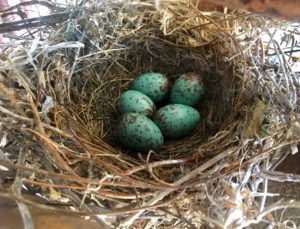
Until next time,
Dani Miller
Wildlife Biologist
Stiles Farm Foundation
—
Dani Miller
Wildlife Biologist
Texas A&M AgriLife Extension Service
Stiles Farm Foundation
5700 FM 1063
Thrall, TX 76578
C: 254-760-6176
Kyra LeJeune Farm Intern
Here is my blog post!!
Howdy! The past few weeks on the farm I have spent much of my time fixing and building fences so we can continue to rotate the cattle herds to maintain forage availability. I have learned a lot about both barbed wire and electric fences. We have fixed mostly barbed wire in the pastures and have run a top electric wire in the places where the barbed wire is too low. This past week, we also constructed an electric fence using t-posts and metal rebar rods to fence off a native grassland restoration area.
A couple of weeks ago, a few of us spent the day penning and loading the northern herd onto a trailer in order to transport them from the northwest pastures to a different set of pastures on the farm known as “Four Corners,” in order to rest the well-grazed pastures and utilize the more abundant forage in Four Corners. The southern herd has also been rotated between a few new pastures in the past few weeks and has needed very little supplemental hay. We continue to have cows birthing calves in both herds, and I have enjoyed spotting the new additions (they are so cute and are my favorite!)
I have also been moving haybales from the hay pasture to the different hay lots around the farm and then lining them up together (which we call “stacking”). Moving hay has allowed me to continue practicing operating the tractor and pulling a trailer with our standard transmission truck.
Though cattle production and management are the areas of agriculture with which I am most familiar, I have enjoyed expanding my knowledge base of the broader industry through the learning opportunities involving agronomy and crops here on the farm. For instance, a few days ago I went to go scout for aphids on one of our milo fields. Additionally, we were able to have some specialists on corn and plant pathology come out to the farm and film their discussions about some common plant diseases affecting crops in Central Texas and the Texas Blackland Prairie this year.
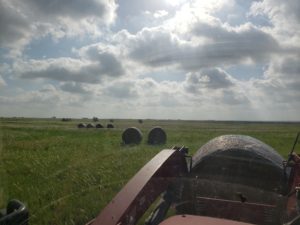
Kyra LeJeune
Farm Intern
Wildlife Biologist Dani Miller Week #55
It’s been a while since my last post as a result of COVID-19 risk mitigation protocols, but I have been able to continue working thanks to the isolated nature of many of my duties. In late April, I planted approximately 50 acres of native grasses and forbs in our Pastures for Upland Birds (PUB) project areas on the farm, using a no-till seed drill graciously loaned to us by the Texas Parks & Wildlife Department. While I was in the tractor planting at our Granger site, I took a fun little video (see the Facebook post) of a Swainson’s hawk (Buteo swainsoni) post-dive; it made what appeared to be a failed attempt to capture a prey item in the thatch, before lifting off when the tractor approached. Regarding the planting itself, I have been monitoring growth ever since, and so far, the results are looking promising. We won’t be able to determine an accurate measure of success for a couple of years while we wait for the natives to establish and hope for adequate rainfall, but I’ve included a few photos of the seedlings, taken about a week ago, which are the short grass and forb sprouts still in visible rows. The invasive johnsongrass (Sorghum halepense) that has grown up over the natives is not ideal, and we are looking into control measures, but there is also hope backed up by outcomes from other native restoration projects in the area that the johnsongrass will die back during the winters while the natives continue to establish, so over time, the johnsongrass will not have the resources to grow back.
The Partners project planning has been progressing well, with the budget for the trail construction approved. In the meantime, I’ve built a convertible picnic-table bench, dubbed the T’bench, that will be the first of six sets, intended to provide outdoor seating for future visitors to what will become a nature education site. The half-mile trail loop has been marked out, with extra care to avoid disturbing the dickcissel (Spiza americana) nest I found along the way (photo included), so now I am just waiting for the project area to finish drying out before I bring in the heavy equipment to begin excavating and laying the trail aggregate. I am looking forward to becoming proficient in the use of a skid steer and roller during this process.
I’ve had quite a few exciting wildlife encounters in my exploits here at the farm since my last post, so I have a selection of additional stories and photos to share. I was able to approach three juvenile armadillos who came out of our HQ haybarn to forage one afternoon. While armadillos are usually nocturnal, a storm front was coming in and I think the little guys got confused by the darkening sky and cooler temps and thought it was evening already and time for a meal! They hung around for about ten minutes, not bothered at all by my presence, before perhaps realizing it was still full daylight and meandering back into the barn for further napping. Nine-banded armadillos are born as identical quadruplets, meaning there are either four males or four females in a litter; hopefully, the fourth sibling of this little band of explorers was just smarter than its compatriots and stayed inside to finish sleeping the day away. During the same afternoon, I rescued a mockingbird fledgling out of well that was too deep for it to flip-flap out on its own. This one must’ve recently flown the coop, and went on its way hopping about and calling to its parents along with a sibling already out in the grass. At this stage, these juveniles are still largely dependent on the parents for food but are out of the nest and in the last stages of learning how to fly and forage on their own. It was quite a red-letter day for me to interact with both the Texas state small mammal and state bird! I also recently encountered a western diamondback rattlesnake while driving around the farm one evening with Kyra, our new farm intern (check out her blog post too!), and while I’ve seen numerous rattlers here, this was the first to actually hold its ground and rattle rather than quietly fleeing. This was a bold and beautiful fellow, and after admiring it from the vehicle, we went our separate ways.
Until next time,
Dani Miller
Wildlife Biologist
Texas A&M AgriLife Extension
Stiles Farm Foundation
—
Dani Miller
Wildlife Biologist
Texas A&M AgriLife Extension Service
Stiles Farm Foundation
5700 FM 1063
Thrall, TX 76578
C: 254-760-6176
Summer Intern Blog Kyra LeJeune
As the new farm intern, I have spent the last two weeks acclimating myself to farm life and all it entails! Since I had very minimal knowledge of farm equipment before starting this internship, I have spent a good amount of time being instructed on farm vehicles and their implements including: the tractor, shredder, hay loader, lawn mower, etc. I have also worked some on general maintenance and upkeep of the vehicles to keep them in good working condition.
Throughout these two weeks, I have also begun to learn the lay of not only the farm, but also the towns of Thrall and neighboring Taylor, in order to know how to reach important places to run errands for the farm. I have picked up items to work or feed cattle at the feed store, dropped off and picked up pieces of tractor equipment at our tractor repair shop, picked up pesticide and herbicide from our chemical supplier, as well as other random assorted items from local hardware stores.
Since I am an animal science major at Texas A&M and my area of focus is on beef cattle, my time is mostly spent working with the two herds of cattle here on the farm. They are mostly Brangus (Brahman and Angus) cross with some other influence such as Hereford (which one can tell from the few “bald” faces we have). Every morning I go check the cattle to make sure they are still in the right pasture, check body condition score (which evaluates the animal’s physical condition health- and nutrition-wise, based on how they appear), possibly move them to a different pasture, and do whatever else needs to be done to ensure their wellbeing. We have been supplementing their forage grazing with hay and cottonseed (which provides a protein source) as needed. This week we also added in some liquid molasses feeders (which provide an energy source) and mineral (which will supplement whichever minerals they are not receiving through the forage, to help prevent mineral deficiencies).
An important aspect of owning cattle is working cattle every few months. We start with trying to train them to come into the pens a week or so before the working by leaving food in the pens. The morning of working them, we try to get most of the cows into the pen with food and the stragglers we will herd in afterwards. Then we will separate out calves and cows/bulls and run the calves through first. They will be herded into a lane so that we can put them into the chute at the end of the lane one at a time. In the chute, the calves will get vaccines they need, a numbered ear tag for identification purposes, and wormer to help combat various parasites the animals may pick up. After the calves are done, the cows and bulls will be run through the lane/chute to also receive vaccines and wormer, numbered ear tags that need replacing, as well as a fly tag to stop flies from biting, which can be an issue for cattle. The cattle are then released back into the pasture until the next time we work them!
It is hard work on a farm, but it has been and continues to be an incredible experience as I broaden my knowledge of agriculture.
Farm Intern
Kyra LeJeune







